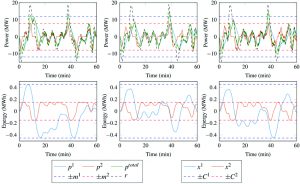Dynamic Energy Management Needs in Energy-Efficient Buildings Imposed by Stochastic Solar Resources
Justin Hughes with adviser A. Domínguez-García
We propose a bilayer control scheme for coordinating the response of distributed energy resources connected to electric power distribution networks to provide frequency regulation services. These resources could include plug-in electric vehicles, flexible loads, and microturbines. We work within a framework in which an aggregator participates in the real-time market by submitting an offer to provide frequency regulation services. The aggregator must then coordinate resources according to the capability which cleared the market and the regulation signal from the market operator.
In the top layer of our proposed controller, this problem is sub-optimally solved using model-predictive control techniques driven by regulation signal forecasts. A second control layer based on traditional automatic generation control is proposed to track faster regulation signal changes. Using numerical simulation studies, we validate the performance of these approaches. Figure 34 shows the power and energy states of two resources performing frequency regulation.
Three different control strategies are compared. The proposed bilayer control (right) finds lower-cost solutions than either layer operating independently (left and center). This research was supported by the Power Systems Engineering Research Center.
